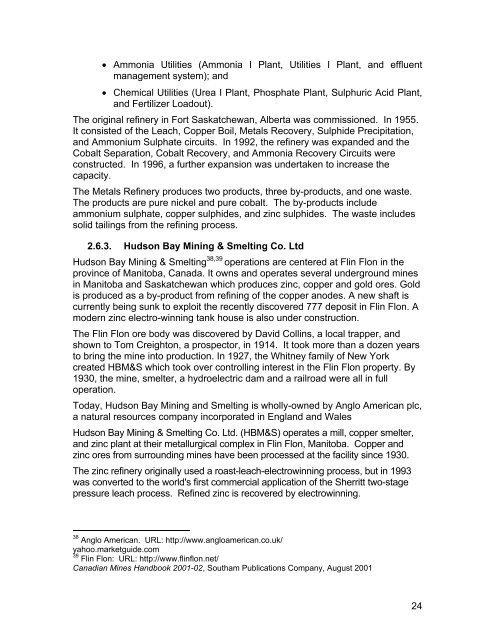(MERAF) for the Base Metals Smelting Sector - CCME
(MERAF) for the Base Metals Smelting Sector - CCME
(MERAF) for the Base Metals Smelting Sector - CCME
You also want an ePaper? Increase the reach of your titles
YUMPU automatically turns print PDFs into web optimized ePapers that Google loves.
• Ammonia Utilities (Ammonia I Plant, Utilities I Plant, and effluent<br />
management system); and<br />
• Chemical Utilities (Urea I Plant, Phosphate Plant, Sulphuric Acid Plant,<br />
and Fertilizer Loadout).<br />
The original refinery in Fort Saskatchewan, Alberta was commissioned. In 1955.<br />
It consisted of <strong>the</strong> Leach, Copper Boil, <strong>Metals</strong> Recovery, Sulphide Precipitation,<br />
and Ammonium Sulphate circuits. In 1992, <strong>the</strong> refinery was expanded and <strong>the</strong><br />
Cobalt Separation, Cobalt Recovery, and Ammonia Recovery Circuits were<br />
constructed. In 1996, a fur<strong>the</strong>r expansion was undertaken to increase <strong>the</strong><br />
capacity.<br />
The <strong>Metals</strong> Refinery produces two products, three by-products, and one waste.<br />
The products are pure nickel and pure cobalt. The by-products include<br />
ammonium sulphate, copper sulphides, and zinc sulphides. The waste includes<br />
solid tailings from <strong>the</strong> refining process.<br />
2.6.3. Hudson Bay Mining & <strong>Smelting</strong> Co. Ltd<br />
Hudson Bay Mining & <strong>Smelting</strong> 38,39 operations are centered at Flin Flon in <strong>the</strong><br />
province of Manitoba, Canada. It owns and operates several underground mines<br />
in Manitoba and Saskatchewan which produces zinc, copper and gold ores. Gold<br />
is produced as a by-product from refining of <strong>the</strong> copper anodes. A new shaft is<br />
currently being sunk to exploit <strong>the</strong> recently discovered 777 deposit in Flin Flon. A<br />
modern zinc electro-winning tank house is also under construction.<br />
The Flin Flon ore body was discovered by David Collins, a local trapper, and<br />
shown to Tom Creighton, a prospector, in 1914. It took more than a dozen years<br />
to bring <strong>the</strong> mine into production. In 1927, <strong>the</strong> Whitney family of New York<br />
created HBM&S which took over controlling interest in <strong>the</strong> Flin Flon property. By<br />
1930, <strong>the</strong> mine, smelter, a hydroelectric dam and a railroad were all in full<br />
operation.<br />
Today, Hudson Bay Mining and <strong>Smelting</strong> is wholly-owned by Anglo American plc,<br />
a natural resources company incorporated in England and Wales<br />
Hudson Bay Mining & <strong>Smelting</strong> Co. Ltd. (HBM&S) operates a mill, copper smelter,<br />
and zinc plant at <strong>the</strong>ir metallurgical complex in Flin Flon, Manitoba. Copper and<br />
zinc ores from surrounding mines have been processed at <strong>the</strong> facility since 1930.<br />
The zinc refinery originally used a roast-leach-electrowinning process, but in 1993<br />
was converted to <strong>the</strong> world's first commercial application of <strong>the</strong> Sherritt two-stage<br />
pressure leach process. Refined zinc is recovered by electrowinning.<br />
38 Anglo American. URL: http://www.angloamerican.co.uk/<br />
yahoo.marketguide.com<br />
39 Flin Flon: URL: http://www.flinflon.net/<br />
Canadian Mines Handbook 2001-02, Southam Publications Company, August 2001<br />
24
















